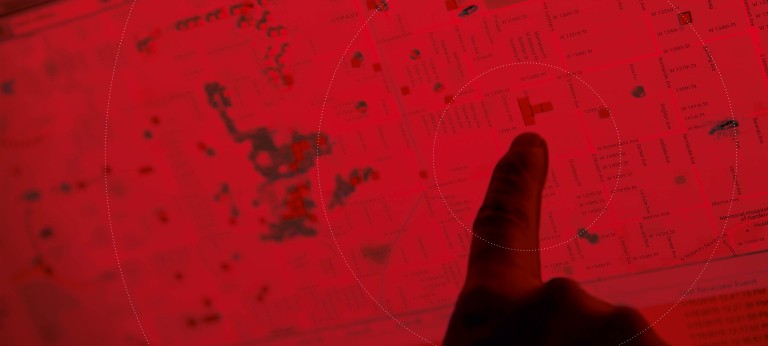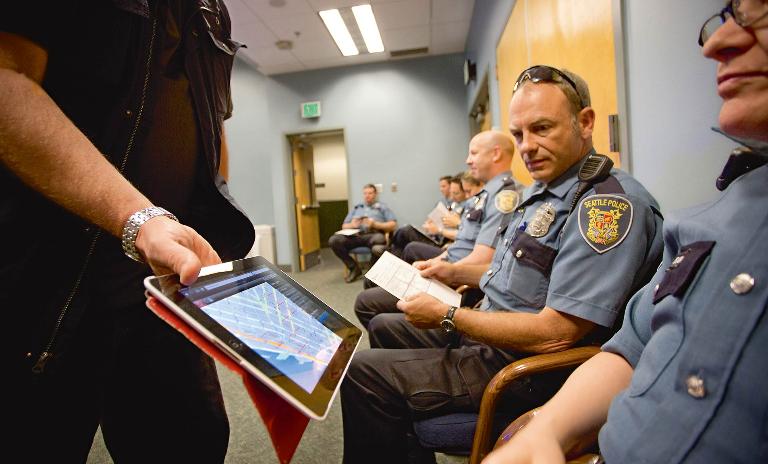Vigilant
![{[downloads[language].preview]}](https://www.rolandberger.com/publications/publication_image/cover_rolandberger_thinkact_21_vigilant_final_download_preview.jpg)
This issue of our Think:Act magazine leads on how global corporations ranging from BASF and Cisco to Corning and Haier are harnessing their innovation skills to pre-empt changes in the business environment.


by Sophie Schimansky
The Los Angeles Police Department has a new recruit, Polly. Polly is software, designed to predict crime. We watch her in action.
That was something I hadn’t counted on. Why wear a bulletproof vest if you already know what’s going to happen? Sergeant Joel Miller leaves me to my embarrassment for a moment. Then he says, drily, "Better safe than sorry," and helps me into it. The vest is heavy and tight, and I feel strangely safe inside it. "If you get shot, it still hurts like hell," says Miller, dampening my high spirits. Minutes later, I hop into the passenger seat of a patrol car, and we’re off. At 80 miles per hour. Blue lights. Screeching sirens. Through Los Angeles. The police radio doesn’t give a moment’s peace; Miller curses the other drivers. The palm trees whisk past us, on the way to my first shooting.
All I wanted to do was get to know Miller’s new colleague. Her name is Polly. She doesn’t need a bulletproof vest. She doesn’t duck out of meetings to pick up coffee and donuts. She is software, and her name is actually PredPol. She works a bit like the PreCogs in "Minority Report". In the film, Tom Cruise always knew 24 hours in advance who was going to get whacked, when and where. Polly can’t do that. She just knows where a crime will be committed in the next 12 hours and what will happen there. She trawls through thousands of pieces of data on murders, accidents and shootings and draws a crime map every 12 hours. Polly can differentiate between robbery, burglary, car thefts or break-ins, vandalism and violent crime.
Predictive Policing using systems like Polly is a trend in policing. It all began with the Los Angeles Police Department (LAPD), which worked with the University of California to develop and test the use of this kind of software. Only once Polly had mastered her job did Captain Jeff Nolte introduce her to Miller and his colleagues – just as they do with new employees. Since then, Nolte has received Polly’s map of horror twice daily. On it there are 10 red boxes marked, each 538 sq ft in size. These are the locations where Polly has calculated the highest probability of a crime.
Miller doesn’t know exactly what awaits him. In any case, it is likely to involve a firearm. Polly told him so.
Polly, the latest version of PredPol, is a slimmed-down program that uses only three data points – crime type, crime location and crime date/time. Around the world, a whole range of Predictive Cops are chasing after gangsters, and most of them can do more than Polly. HunchLab does not only analyze place and time to identify possible crime locations, but it also looks at the weather or socio-economic data. The New York Police Department (NYPD) is trialing this software in a pilot project. In Chicago, their software spits out a Heat List. This list contains the names of possible perpetrators who could threaten someone with a weapon in the near future. In China, a state-owned company is working on software that will gather information including the job, hobbies and consumer habits of the general population. The intention is to track down terrorists.
So how does predictive policing work? How can we be sure that Polly has prevented a crime if it never took place? "There’s no answer to that question," says Jeff Nolte. "If a crime is prevented, nobody ever hears about it." Nolte then pulls his ace from his sleeve and gives me evidence of Polly’s efficiency with crimes that she did predict, but not prevent. Polly predicted 21% of house burglaries, she knew about 18% of car thefts and 20% of car break-ins. Nolte follows this with, "Just because I theoretically know the risks better, I still don’t have more staff."
Even if PredPol helps, it doesn’t replace patrols. And Nolte has to prioritize. In the beginning, the software drew 15 boxes on the map twice a day, but now there are only 10.
Today, he has sent Miller and me on one of Polly’s leads, heading to the South Alvarado Street area. I sit next to Miller and hold tightly to the handle above the door. I can’t imagine how Miller can control the traffic and his vehicle at this speed. Even my bulletproof vest won’t help me if we crash. Miller tells me that after 20 years in LA, he can read people like a book. He’s the stereotypical cop – crew cut, black sunglasses. I stare at the map that Polly created. It’s hard to believe that a murderer could be hiding behind that little symbol. Miller doesn’t know exactly what awaits him. In any case, it is likely to involve a firearm. Polly told him so.
We arrive at the intersection of South Alvarado Street and Wilshire Boulevard. Miller stops in the middle of the street and leaps from the car. "Stay with me," he yells to me. I hastily make my way around the car and take cover behind his broad back. Suddenly, I’m glad to have my bulletproof vest. Outside a 99 Cents Only store, people are pouring onto the sidewalk, as Miller’s colleagues try to keep them in check. Suddenly a woman runs into the middle of the street, sobbing and throwing her hands into the air. Sergeant Miller shouts at her to get out of the road, but his colleagues have already grabbed the woman and got her to safety.
The reason for the excitement lies unobtrusively at the edge of the road: a pistol. However, it is impossible to identify a shooter in the crowd of people, or a victim either. Within a few minutes, Miller has found out what happened: a man threatened two others with a firearm, but ran away when one of the two drew his gun. The gun left behind was that of the attacker, which he had thrown away for whatever reason. The howl of sirens hangs over the scene.
Sirens are part of the sound of LA, filling the City of Angels on a daily basis. Los Angeles is the home of celebrities – and of crime. According to the LAPD, this metropolis of 3.8 million people sees some 450 gangs with 45,000 members going about their business. Mind you, it has gotten quieter since the ‘90s. The number of gang members, however, has been rising again over the last few years. In 2015, criminal statistics worsened for the first time in 10 years, with violent crime up by 20% in comparison with 2014 and property crimes such as break-ins up 10%.
"My shooting" outside the 99 Cents Only store took place in Rampart, a particularly densely populated problem area with 375,000 inhabitants in 5.4 sq mi, where criminal incidents are especially high. Rampart is home to Echo Park and MacArthur Park, two flashpoints where prostitution, gang crime and a correspondingly high number of shootings rock Rampart all year round.
That’s why Polly is coming to the rescue of her colleagues. To do this, she has analyzed crime statistics for the last 10 years and followed two patterns. "The first is the re-victimization principle," says Jeff Brantingham, Professor of Anthropology at the University of California in Los Angeles and the inventor of Polly. "Anyone or even anything that has ever been a victim of crime is highly likely to become a victim again," he explains. Re-victimization affects people just as much as cars or houses that have been broken into. If a criminal sees a house or a person as an easy and worthwhile victim the first time, he is highly likely to strike again. And this likelihood is highest in the first 24 hours after the crime. "Even criminals want to be efficient and get the maximum profit at the lowest possible cost," says Brantingham.
The second pattern for Polly results from criminal behavior. "Certain situations regularly give rise to crimes," says Brantingham. One example is a high school. Young men would have an urge to prove themselves, kicking in windows or setting light to trashcans.
Nolte was initially somewhat skeptical when Brantingham introduced him to Polly. After 14 years as a murder investigator, this software was now going to tell him and his colleagues where they should go. Many of his colleagues are still mistrustful, says Nolte. "We’re all proud police officers, who rely on our experience and intuition. We don’t need any ‘magic fairy dust’."
That’s what Miller thinks too. In the meantime, the crime scene at the 99 Cents Only store has been cordoned off and peace has returned. It’s time for the team to get together and discuss what needs to happen next. The sun is burning, there is no shade at the intersection, and I am melting in my bulletproof vest. Miller spits on the ground and says, "You could have predicted that even without Polly. This corner is always hot." A colleague seconds him and says, "This software is the latest shit: expensive and superfluous."
Detectives have worked the beat here for years; they know every corner and every gang in Rampart. They trust the Crime Analysis Detail Team, their flesh and blood colleagues, who compile data and make their own predictions. But they don’t trust an algorithm.
This metropolis of 3.8 million people sees some 450 gangs with 45,000 members going about their business.
And those doubts go far beyond the patrol officers in LA. In these times of whistle-blowing, the NSA and Edward Snowden, social networks and data theft, anything that smells of surveillance has a hard time, says Kevin Miller, a lawyer who published a paper on this new technology two years ago. He also investigated the effects of predictive policing on data protection. The risk of relying on algorithms is not just that the software can make mistakes. "What’s even more dangerous," he explains, "is that it is impossible to identify these mistakes if you can’t decode the algorithm."
Jeff Nolte and his team don’t know how Polly’s algorithm works – they have never even seen one of the equations, let alone solved one. Nevertheless, they follow Polly’s advice. However, once an incorrect correlation sneaks into the source code, Polly would always repeat this error and thus confirm itself, criticizes Miller. In the end, no one would be responsible for an error, because the software had made the mistake.
A well-known example of this kind of mistake is the surveillance of people and their online activity. After the bomb attacks in Boston in the spring of 2013, someone near the victims searched the internet for the terms "rucksack" and "pressure cooker." "Shortly afterward, they found the police outside their house," says Kevin Miller. It was an unpleasant experience for those involved and a waste of valuable police time. However, he regards the predictive policing method of creating criminal profiles as even more dangerous. "It places a whole group of people who fit this profile under general suspicion."
There’s not quite so much at stake with Polly because she only limits herself to the risk at certain flashpoints over time, leaving people completely out of the equation, explains inventor Brantingham. And Nolte reiterates that no matter how great the software is, it still doesn’t tell them what to do. "Polly just tells me where I should send my colleagues – but I make that decision." Even so, it seems that even he doesn’t quite believe in Polly. When I suggested that he should put up posters in Rampart to inform criminals of Polly’s skills, he was very calm. He nodded slowly, thought for a moment and then said, "But you know how everyone reacts to the idea of Big Brother." He doesn’t want people to feel watched.
Telling criminals about this new super- software could have a deterrent effect. On the other hand, it could mean that criminals change their patterns, seeking out new places and using new methods. "I know my criminals, and it’s only an advantage as long as they don’t know what I know," says Nolte.
As I squeeze out of the patrol car that afternoon, Joel Miller offers me his hand. I have to catch my flight, but he still has a few boxes on Polly’s map ahead of him. He wants to give his new colleague a chance. "I’m a technology fan, as long as it makes my life easier." When it comes to Polly, that’s not yet certain. Just like the young recruits from the Police Academy, she needs to earn her stripes.
Other systems are establishing themselves alongside PredPol.

![{[downloads[language].preview]}](https://www.rolandberger.com/publications/publication_image/cover_rolandberger_thinkact_21_vigilant_final_download_preview.jpg)
This issue of our Think:Act magazine leads on how global corporations ranging from BASF and Cisco to Corning and Haier are harnessing their innovation skills to pre-empt changes in the business environment.
Curious about the contents of our newest Think:Act magazine? Receive your very own copy by signing up now! Subscribe here to receive our Think:Act magazine and the latest news from Roland Berger.

